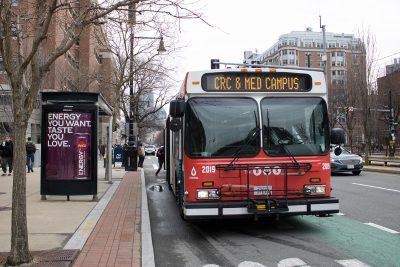
On its daily runs along Commonwealth Avenue, the Boston University Shuttles make frequent stops to pick up and drop off students. While doing so, they block newly-introduced bike lanes that have been implemented throughout the city.
According to Colin Riley, a BU spokesperson, the buses have to stop in the bike lanes because there is no other way to reach the curb where passengers must board and disembark.
“There’s circumstances where the bus can’t pull all the way to the curb without using and crossing the bike lanes,” Riley said.
Vineet Gupta, planning director for the Boston Transportation Department, said this is a problem that city busses encounter as well.
“This is often the case throughout the country in many places, and in Boston as well, where the bus, in fact, pulls up across the bike lane to get to the sidewalk where people are waiting to board the bus,” Gupta said. “There is not a way for passengers to kind of stand in the middle of the street.”
Gupta said there are precautions in place to alert vehicles and bicyclists of possible interference with the bike lanes. He said that bike lanes will either have dotted lines and, or be painted green in order to warn of bicyclists of incoming traffic.
“It tells bus drivers that there’s going to be a conflict coming up, when they see the green paint, between their access to the curb and people who are on bicycles,” Gupta said.
Gupta also said that there are courses bus drivers must take before getting on the road to learn how to interact with the bike lanes. Drivers are also meant to use their directionals before pulling over, whether it be through a bike lane or just to the curb.
“Bicyclists are sensitive to how the bus operates,” Gupta said. “And bus drivers are keeping an eye on people who are on bicycles on the street.”
Riley said that BU shuttle bus drivers must also follow the rules that Gupta mentioned.
“We ask them to understand that a bus cannot pull all the way up to the curb without using or crossing the bike lane,” Riley said. “And that the drivers are professional and they are going to exercise caution to use their signals and make sure the bike lane is clear so that they can safely open the doors and let passengers board or disembark.”
Riley said traffic problems with the shuttle bus and bike lanes are created so often because students frequently use the shuttle for short trips down Commonwealth Ave., as opposed to going from the Charles River Campus to the Fenway or Medical Campus, or just from one end of CRC to the other.
“We just want people to use good judgment, not only our drivers but pedestrians, other vehicle operators and bicyclists and people on skateboards or scooters, so that [travel] can be done safely,” Riley said. “It’s really to try to show some courtesy, respect and common sense.”
Gupta said future planning for bus stops will try to avoid having buses pull up to the curb to let passengers on and off.
“Any new design that we do has a sidewalk, then the bike lane, then the area for people to stand to board the bus,” Gupta said, “so that the bus does not have to pull into the bike lane.”
Heather Slutsky, a sophomore in the College of Arts and Sciences, said she thinks biking in Boston is generally dangerous, especially on bus routes.
“I do think it’s a possible hazard [to have buses in bike lanes],” Slutsky said. “But the [city] buses also do that, and it is dangerous to bike on campus in general. So I don’t think out of the hazards to bikers the bus is the biggest issue.”
Erin Dixon, a senior in CAS, said while she doesn’t bike, she can see the nuisance of having to deal with buses.
“I definitely think that the [bus drivers] should be educated on bikers,” Dixon said. “Especially because I know – I personally don’t have a bike but a lot of my friends do – and I know that they get nervous and they have to drive into the actual road [to avoid the bus].”
Ben Weitzman, a freshman in the Sargent College of Health and Rehabilitation Sciences, is a frequent shuttle bus user and he said that regardless of the hazards of having the bus, he does find it convenient.
“I find it super reliable,” Weitzman said. “Especially in the morning. I live in West [campus] and it runs pretty much on time. And while the schedule on the app is not super reliable, if you just wait for it, it’s usually a good way to get back to the dorm.”


















































































































